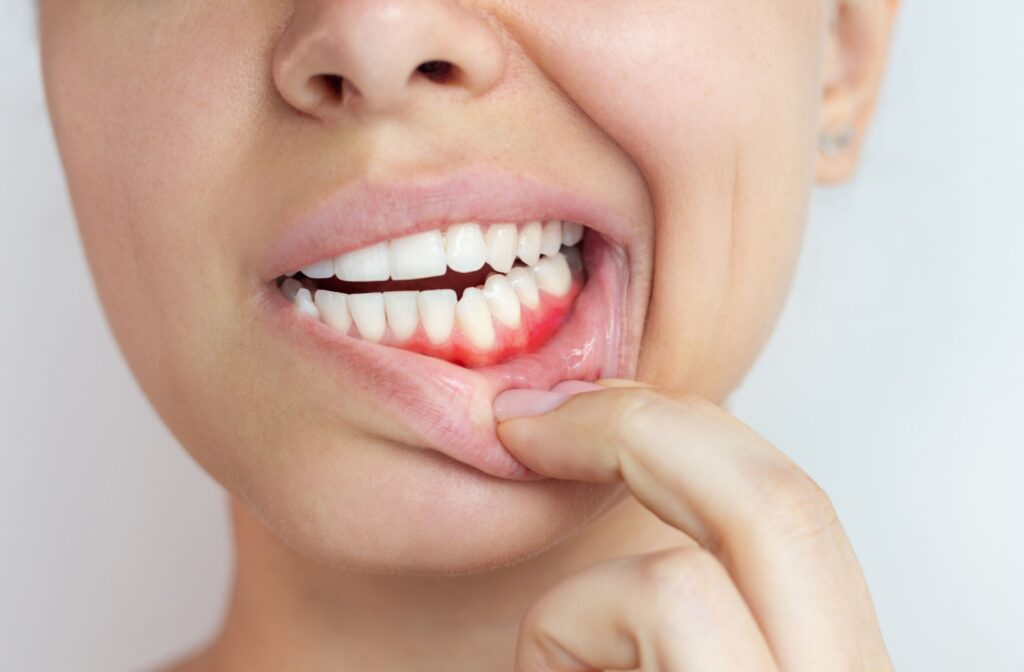You work hard to keep your family healthy, and their oral health is a big part of that picture. Parents often ask us if gum disease can spread from one person to another, like a common cold. We want to help you understand how the bacteria linked to gum disease can be shared and what you can do to protect your family’s smiles.
While you can’t catch gum disease like the flu, the bacteria that cause it can be passed from one person to another. This happens through saliva, which means that close contact and sharing certain items can increase the risk of transferring these specific germs within your family.
What Is Periodontal Disease?
Periodontal disease, or gum disease, is an infection that affects the gums and the bone that supports your teeth. It usually starts when plaque, a sticky film of bacteria, builds up on your teeth and isn’t removed. Over time, this can lead to inflammation and, in more serious cases, tooth loss.
The 2 Stages of Gum Disease
Gum disease progresses in 2 main stages, each with its own signs:
- Gingivitis: This is the earliest stage of gum disease. You might notice that your gums are red, swollen, or bleed easily when you brush. The good news is that gingivitis is often reversible with professional care and good oral hygiene at home.
- Periodontitis: If left untreated, gingivitis can advance to periodontitis. At this stage, the infection can damage the soft tissue and bone that hold your teeth in place. This is a more serious condition that requires professional management.
How Gum Disease Bacteria Spreads
The specific bacteria that cause gum disease can be found in saliva. This means you can’t get it from just being in the same room as someone. However, these bacteria can be transferred through direct contact with an infected person’s saliva.
Kissing & Close Contact
A kiss can transfer saliva from one person to another. While a quick peck is unlikely to cause an issue, prolonged and frequent kissing with someone who has gum disease can increase your exposure to harmful bacteria.
Share Utensils, Cups, & Toothbrushes
In a busy family household, it’s easy to accidentally share things. Using the same fork, drinking from the same glass, or using someone else’s toothbrush can easily transfer oral bacteria. It’s a good practice for everyone to have their own personal items.
Common Signs & Symptoms to Watch For
Knowing what to look for can help you catch gum disease early, when it’s much easier to manage. If you or a family member notices any of these signs, it may be time to see a dentist. Prompt attention can make a significant difference. Signs can include:
- Gums that bleed during or after you brush or floss
- Red, puffy, or tender gums
- Bad breath that doesn’t go away
- Gums that appear to be pulling away from the teeth
- Teeth that feel loose or a change in how your teeth fit together
- Discomfort or pain when you chew
Prevention for You & Your Family
The most effective way to protect your family from gum disease is to prevent it from happening in the first place. Building strong oral hygiene habits together not only protects your smiles but also teaches your children valuable lessons for life. A consistent routine is your family’s first line of defense.
Your Daily Routine at Home
Simple daily actions can have a huge impact on your family’s oral health. Following the right brushing and flossing techniques is key to an effective routine.
- Brush twice a day: Make sure everyone brushes their teeth for 2 minutes each morning and before bed with a soft-bristled brush and fluoride toothpaste.
- Floss every day: Flossing cleans plaque and food from between your teeth and under the gumline where a toothbrush can’t reach.
- Use mouthwash: An antimicrobial mouthwash can help reduce the amount of bacteria in your mouth and freshen your breath.
The Role of Regular Dental Visits
Your at-home care is very important, but it works best when combined with regular professional visits. A dental hygienist can remove hardened plaque—called tartar—that you can’t get rid of with brushing alone. This helps keep your gums healthy and clean.
Regular check-ups also allow your dentist to spot the very first signs of trouble. Early detection of gingivitis can stop it from progressing into a more serious problem. Our exams are designed to be clear, comfortable, and informative.

Professional Treatment Options
For mild periodontitis, a deep cleaning (scaling and root planing) is often recommended. This procedure cleans plaque and tartar from below the gumline and smooths the tooth roots to help your gums reattach. For more advanced cases, other treatments can help restore lost tissue and reduce the depth of gum pockets.
Strong Smiles Start at Home
Protecting your family’s oral health is a team effort, and we’re here to support you. Understanding how to prevent the spread of harmful bacteria is a great step toward keeping everyone’s smile bright and healthy. A strong foundation of home care and regular check-ups is the key to prevention.
If you have any concerns about your family’s gum health or it’s time for a check-up, contact us at CHV Dental. We offer a wide range of services for the whole family and are happy to help you get on track.


